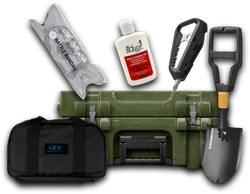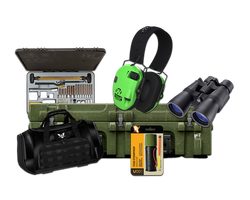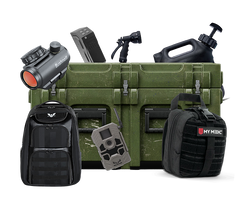What Is a Crowbar Made Of? Understanding the Material Science Behind This Essential Tool
Table of Contents
- Introduction
- The Basics of Crowbars
- The Composition of Crowbars
- Properties of Crowbar Steel
- Crate Club and Quality Tactical Gear
- Conclusion
- FAQ
Introduction
Have you ever looked at a crowbar and wondered about its composition? This seemingly simple tool is a staple in many toolboxes, yet few people stop to appreciate the engineering that goes into its creation. Crowbars are used in a variety of applications, from prying open stubborn doors to aiding in demolition work. But what truly sets a crowbar apart is the material it’s made from.
Crowbars are often crafted from medium to high carbon steel, a choice that significantly influences their performance and durability. Understanding the science behind these materials not only highlights their importance but also enhances our appreciation for quality tools. In this blog post, we’ll delve into the specifics of what crowbars are made of, the properties of the steel used, and the various applications that benefit from this robust tool.
By the end of this article, you will have a comprehensive understanding of crowbars, including their material composition, manufacturing processes, and practical uses in both casual and professional settings. Moreover, we'll explore how high-quality tools, like those offered by Crate Club, can elevate your preparedness and tactical capabilities.
The Basics of Crowbars
What is a Crowbar?
A crowbar, also known as a pry bar, is a simple hand tool consisting of a long, straight metal bar with a curved end. It is primarily used for prying, lifting, and removing nails or other fasteners. Crowbars come in various sizes, with the length and thickness varying based on their intended use.
Common Uses of Crowbars
Crowbars serve a wide array of purposes, including:
- Prying Open Objects: A crowbar is ideal for opening tightly sealed doors, lids, or containers.
- Demolition: They are essential in construction and demolition projects, allowing workers to remove materials with ease.
- Lifting Heavy Objects: The leverage provided by a crowbar makes it easier to lift heavy items that would otherwise be difficult to move.
- Removing Nails: The pointed end of a crowbar can be used to remove nails from wood or other materials.
Importance of Material Composition
The effectiveness of a crowbar can largely be attributed to the materials used in its construction. High-quality steel provides the strength and durability necessary for the tool to perform effectively without bending, breaking, or wearing down.
The Composition of Crowbars
Steel Types Used in Crowbars
Most crowbars are made from either medium carbon steel or high carbon steel. Here’s a closer look at these materials:
1. Medium Carbon Steel
Medium carbon steel typically falls within the range of 0.3% to 0.6% carbon content. This type of steel balances ductility and strength, making it suitable for a variety of tools, including crowbars. Common grades of medium carbon steel used in crowbars include:
- AISI 1030: This steel grade offers good weldability and machinability, making it a popular choice for manufacturing crowbars.
- AISI 1045: Known for its high tensile strength, AISI 1045 is often used in applications requiring more durability and resistance to wear.
2. High Carbon Steel
High carbon steel contains more than 0.6% carbon content, which enhances its hardness and strength. However, this also makes it less ductile, meaning it may be more prone to breakage under certain conditions. High carbon steel grades commonly found in crowbars include:
- AISI 1070: This grade is known for its high strength and excellent wear resistance.
- AISI 1080: Often used for tools requiring a sharp edge, AISI 1080 is durable and holds up well under stress.
Manufacturing Process
The manufacturing of crowbars involves several stages, including:
- Material Selection: Choosing the appropriate steel grade based on the intended use of the crowbar.
- Forging: The steel is heated and shaped into the crowbar form, which enhances its strength and durability.
- Heat Treatment: The forged crowbar undergoes heat treatment to improve its hardness and resistance to wear.
- Finishing: Finally, the crowbar is polished and coated to prevent rust and corrosion.
Properties of Crowbar Steel
Strength and Durability
The primary concern for any tool, especially one used for heavy-duty tasks, is its strength. Crowbars made from high-quality steel exhibit exceptional tensile strength, allowing them to withstand significant force without bending or breaking.
Corrosion Resistance
Steel is susceptible to rusting when exposed to moisture, which can significantly reduce the lifespan of a tool. Many manufacturers apply protective coatings to crowbars to enhance their corrosion resistance. This is especially important for tools that may be exposed to the elements or stored in damp environments.
Ductility and Hardness
The balance between ductility and hardness is crucial in crowbar design. While a harder tool can withstand more force, it may also be more brittle. The ideal crowbar will strike a balance, allowing for both strength and flexibility under stress.
Crate Club and Quality Tactical Gear
At Crate Club, we understand the importance of having reliable, high-quality tools at your disposal, whether you're preparing for outdoor adventures or tackling home improvement projects. Our subscription services offer a curated selection of top-notch tactical gear, including crowbars that meet the highest standards of quality and durability.
Crate Club Subscription Services
Crate Club provides four tiers of subscriptions, catering to different levels of preparedness and tactical needs. Each tier offers an array of gear designed to enhance your readiness for any situation:
- Lieutenant Tier: At $49.99/month, this tier is perfect for casual or new tacticians. It includes essential survival and self-defense tools, including compact crowbars for light tasks.
- Captain Tier: For $99.99/month, you gain access to a selection of premium survival tools and outdoor essentials, ensuring you're prepared for everyday challenges.
- Major Tier: At $199.99/month, this tier is designed for experienced survivalists, offering premium gear that has passed rigorous testing.
- General Tier: For $399.99 quarterly, this tier provides professional-grade tactical gear, including custom crowbars used by industry experts.
Explore our subscription offerings to find the perfect fit for your tactical lifestyle here.
Crate Club Shop
In addition to our subscriptions, Crate Club also features a shop where you can purchase individual items, including high-quality crowbars and other essential tools. Browse through our collection to find gear that meets your specific needs here.
Conclusion
Understanding what a crowbar is made of not only informs your choices when selecting tools but also enhances your preparedness for various tasks. The balance of strength, durability, and corrosion resistance in medium and high carbon steel makes it an ideal choice for crowbars. Whether you're a novice DIY enthusiast or a seasoned professional, investing in quality tools is essential for efficiency and safety.
As you consider your options for tactical gear, remember that Crate Club is dedicated to providing you with high-quality products that empower you to tackle any challenge. With our subscriptions and shop offerings, you can ensure that you have the right tools to enhance your tactical capabilities.
FAQ
1. What type of steel is best for making a crowbar? Medium carbon steel, such as AISI 1045, is commonly used for crowbars due to its balance of strength and ductility. High carbon steel, like AISI 1080, is also effective but may be less flexible.
2. Can I use a crowbar for demolition work? Absolutely! Crowbars are ideal for demolition tasks as they provide the leverage needed to remove materials with ease.
3. How do I maintain my crowbar? Keep your crowbar clean and dry to prevent rust. If it has a protective coating, ensure it remains intact, and consider applying oil to lubricate any moving parts.
4. Where can I purchase high-quality crowbars? You can find reliable crowbars and other tactical gear at Crate Club's shop here.
5. Why is steel the preferred material for crowbars? Steel offers the necessary strength, durability, and resistance to wear that is essential for tools that are subjected to high levels of stress and force.
Share this article



